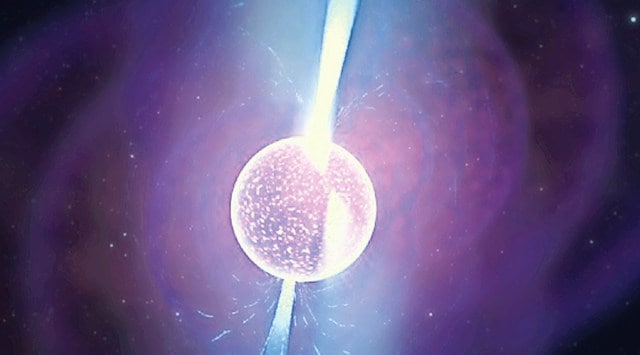Click here to join Express Pune WhatsApp channel and get a curated list of our stories
Pune astronomers detect two new millisecond pulsars
MSPs are dense, tiny neutron stars, which are formed when a massive star (for example, the Sun) collapses.
 An artist’s impression of a neutron star with pulsed emission. Courtesy : NCRA
An artist’s impression of a neutron star with pulsed emission. Courtesy : NCRA PUNE-BASED astronomers have discovered two new Millisecond Pulsars (MSP) — rotating neutron stars — using an indigenously developed novel technique, which was applied during an ongoing sky survey conducted by the Giant Metrewave Radio Telescope (GMRT).
MSPs are dense, tiny neutron stars, which are formed when a massive star (for example, the Sun) collapses.
They are named pulsars because they emit pulses of radiation at regular intervals. Millisecond pulsars emit radiations every few milliseconds.
The properties of these radiations can reveal key information about the neutron stars, which are the densest bodies in the universe excluding blackholes.
Additionally, chances of detection of gravitational waves are higher when there is a significant population of MSPs in a region. The study of gravitational waves is one of the keenly watched fields in astronomy currently.
Operational since early 2000, the GMRT, located about 80 km from Pune city, is the world’s largest radio telescope operating in low radio frequency. It is owned by the TIFR-National Centre for Radio Astrophysics (NCRA), Pune.
The new gated imaging technique, researchers said, provided them higher precision timing in predicting the incoming pulse (signals) from MSP. These pulses emitted by pulsars are visible to humans only when they are directed towards Earth, similar to flashes emerging from lighthouses.
“The advantage of this technique is that we can study the pulsar parameters with higher precision in comparison to the standard imaging techniques, which are time consuming. The location of the new MSPs was precisely calculated using the technique and it now adds to the international programmes in the search for the imprint of the gravitational wave backgrounds,” the NCRA scientists said.
During an ongoing GMRT-High-Resolution Southern Sky (GHRSS) survey, led by Bhaswati Bhattarcharya, the NCRA team successfully discovered 30 new pulsars including three MSPs. Two MSPs were studied further by Shyam Sundar, a PhD student, using the new technique.
“We could achieve a 3,000-fold enhancement in fixing the positional uncertainty. The recent upgrades in the operating bandwidth of GHRSS have enhanced its capacity to detect even fainter MSPs,” the scientists said.
Click here to join Express Pune WhatsApp channel and get a curated list of our stories







